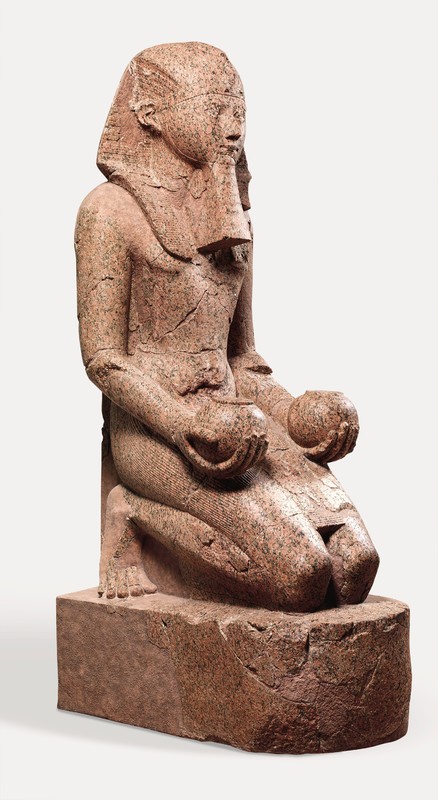Large Kneeling Statue of Hatshepsut
Title
Large Kneeling Statue of Hatshepsut
Date
Dynasty 18, ca. 1479-1458 B.C.
Artist or Workshop
Unknown
Materials
granite
Height of the work
261.5 cm tall
Provenience
Egypt, Upper Egypt, Thebes, Deir el-Bahri, Senenmut Quarry, MMA excavations, 1927-28
Current Location
The Metropolitan Museum of Art, New York City, New York
Description and Significance
Description:
The ‘Large Kneeling Statue of Hatsheput’ presents a large female figure kneeling atop a rectangular slab with a rounded front. She wears a nemes headdress of incised lines that wraps around her forehead and extends to her shoulders and stops just above the breast, a false beard that flares out slightly at the bottom and creates a solid block at her upper chest, and a shendyt kilt that ends just above the knees. Her face, with its sharp, chiseled features and incised eyes, broad shoulders, understated breasts along with her regal attire, characterize the Ancient Egyptian conventions of a male pharaoh. Formed of hard granite, the statue exudes a stoic strength, with a rigid, straight back, and bent knees with curled feet pressing down on the base. Her arms, bent at the waist, lead to hands tilted up, cupping two round, palm-sized vessels, called nu-pots, used as offerings to the god Amun, according to the inscription at the statue’s base. Cracks appear throughout the granite, denoting the deliberate damage the rough, grainy surface, which has been re-assembled and restored by the Metropolitan Museum of Art with a plaster fill.
Significance:
Rendered in the millennia old Egyptian visual iconography, the statue boldly expresses King Hatsheput’s endurance as pharaoh. Although considered a queen earlier in life, Hatsheput, whom the statue portrays, ascended to power following her husband Thutmose II’s death. By 1473 B.C., scholars note that she wore male pharaoh regalia and created her own mythology, claiming to be the daughter of Thebes’ supreme god, Amun, in order to establish her authority. This particular statue was created after that time, and probably commissioned by Hatsheput herself along with hundreds of other portraits she mandated, which imbues its strong, kingly features with a greater sense of power. Originally seated in the middle terrace of Hatsheput’s mortuary temple, the statue, in kneeling position, would present its raised offerings to the statue of Amun-Re that passed from Thebes across the Nile to a shrine in the back of temple for one night during the Beautiful Feast of the Valley. This kneeling posture not only showed Hatsheput’s reliance and submission to Amun, but also testified to her own role in partaking in a ritual of the living, even after her death, implying her eternal position as a king/god in the afterlife, and heralded by the enormity of the statue. Though its cracks reflect the efforts of her step-son, Thutmose III, to expunge her name from history, the statue now sits proudly in the Metropolitan Museum of Art, a lasting symbol to new generations of the legacy Hatsheput proclaimed for herself.
The ‘Large Kneeling Statue of Hatsheput’ presents a large female figure kneeling atop a rectangular slab with a rounded front. She wears a nemes headdress of incised lines that wraps around her forehead and extends to her shoulders and stops just above the breast, a false beard that flares out slightly at the bottom and creates a solid block at her upper chest, and a shendyt kilt that ends just above the knees. Her face, with its sharp, chiseled features and incised eyes, broad shoulders, understated breasts along with her regal attire, characterize the Ancient Egyptian conventions of a male pharaoh. Formed of hard granite, the statue exudes a stoic strength, with a rigid, straight back, and bent knees with curled feet pressing down on the base. Her arms, bent at the waist, lead to hands tilted up, cupping two round, palm-sized vessels, called nu-pots, used as offerings to the god Amun, according to the inscription at the statue’s base. Cracks appear throughout the granite, denoting the deliberate damage the rough, grainy surface, which has been re-assembled and restored by the Metropolitan Museum of Art with a plaster fill.
Significance:
Rendered in the millennia old Egyptian visual iconography, the statue boldly expresses King Hatsheput’s endurance as pharaoh. Although considered a queen earlier in life, Hatsheput, whom the statue portrays, ascended to power following her husband Thutmose II’s death. By 1473 B.C., scholars note that she wore male pharaoh regalia and created her own mythology, claiming to be the daughter of Thebes’ supreme god, Amun, in order to establish her authority. This particular statue was created after that time, and probably commissioned by Hatsheput herself along with hundreds of other portraits she mandated, which imbues its strong, kingly features with a greater sense of power. Originally seated in the middle terrace of Hatsheput’s mortuary temple, the statue, in kneeling position, would present its raised offerings to the statue of Amun-Re that passed from Thebes across the Nile to a shrine in the back of temple for one night during the Beautiful Feast of the Valley. This kneeling posture not only showed Hatsheput’s reliance and submission to Amun, but also testified to her own role in partaking in a ritual of the living, even after her death, implying her eternal position as a king/god in the afterlife, and heralded by the enormity of the statue. Though its cracks reflect the efforts of her step-son, Thutmose III, to expunge her name from history, the statue now sits proudly in the Metropolitan Museum of Art, a lasting symbol to new generations of the legacy Hatsheput proclaimed for herself.
References
http://www.metmuseum.org/art/collection/search/544449
https://www.khanacademy.org/humanities/ancient-art-civilizations/egypt-art/new-kingdom/v/mortuary-temple-of-hatshepsut-and-large-kneeling-statue-new-kingdom-egypt
https://www.khanacademy.org/humanities/ancient-art-civilizations/egypt-art/new-kingdom/v/mortuary-temple-of-hatshepsut-and-large-kneeling-statue-new-kingdom-egypt
Contributor
Charlotte Mann
Citation
Unknown, “Large Kneeling Statue of Hatshepsut,” Digital Portrait "Basket" - ARTH488A "Ancient Mediterranean Portraiture", accessed June 6, 2025, http://classicalchopped.artinterp.org/omeka/items/show/5.
Item Relations
This item has no relations.

